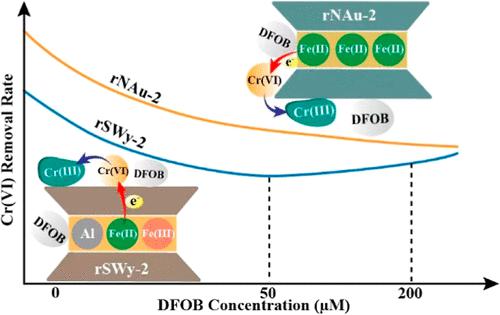当前位置:
X-MOL 学术
›
Environ. Sci. Technol.
›
论文详情
Our official English website, www.x-mol.net, welcomes your feedback! (Note: you will need to create a separate account there.)
Cr(VI) Reduction by Siderophore Alone and in Combination with Reduced Clay Minerals
Environmental Science & Technology ( IF 11.4 ) Pub Date : 2022-08-15 , DOI: 10.1021/acs.est.2c04104 Donglei Zhang 1, 2 , Xiaolei Liu 1, 3 , Dongyi Guo 1 , Gaoyuan Li 1 , Junhua Qu 1 , Hailiang Dong 1
Environmental Science & Technology ( IF 11.4 ) Pub Date : 2022-08-15 , DOI: 10.1021/acs.est.2c04104 Donglei Zhang 1, 2 , Xiaolei Liu 1, 3 , Dongyi Guo 1 , Gaoyuan Li 1 , Junhua Qu 1 , Hailiang Dong 1
Affiliation

|
Siderophores and iron-containing clays are known to influence the transformation of chromium in the environment. The role of clays in hexavalent chromium [Cr(VI)] reduction has been reported extensively. However, the mechanisms of Cr(VI) reduction by siderophores and their combination with iron-bearing clays are poorly known. Herein, we report the kinetics and products of Cr(VI) reduction by a siderophore alone or in combination with reduced clays. Results showed that Cr(VI) reduction by a tri-hydroxamate siderophore─desferrioxamine B (DFOB)─at a pH of 6 was achieved by one-electron transfer via the formation of Cr(V) intermediate. The formed Cr(V) was further reduced to organically complexed Cr(III). The Cr(VI) reduction rate and extent in the presence of both DFOB and reduced clays unexpectedly decreased relative to that with reduced clays alone, despite both serving as Cr(VI) reductants. The interaction between DFOB and clays (e.g., adsorption/intercalation, dissolution, and/or oxidation) was primarily responsible for Cr(VI) reduction inhibition. The extent of inhibition increased at higher DFOB concentrations in the presence of iron-rich nontronite but decreased in the presence of iron-poor montmorillonite, which may be related to their different Cr(VI) reduction mechanisms. This study highlights the importance of siderophores in chromium transformation and its impact on the reactivity of iron-bearing clays toward heavy metal reduction in the environment.
中文翻译:

单独使用铁载体和与还原粘土矿物结合还原 Cr(VI)
众所周知,铁载体和含铁粘土会影响铬在环境中的转化。粘土在六价铬 [Cr(VI)] 还原中的作用已被广泛报道。然而,铁载体还原 Cr(VI) 的机制及其与含铁粘土的结合却鲜为人知。在此,我们报告了单独使用铁载体或与还原粘土结合还原 Cr(VI) 的动力学和产物。结果表明,在 pH 值为 6 时,三异羟肟酸铁载体─去铁胺 B (DFOB) 对 Cr(VI) 的还原是通过形成 Cr(V) 中间体的单电子转移实现的。形成的 Cr(V) 进一步还原为有机络合的 Cr(III)。在 DFOB 和还原粘土存在的情况下,Cr(VI) 的还原速率和程度相对于单独还原粘土的情况出乎意料地降低,尽管两者都用作 Cr(VI) 还原剂。DFOB 和粘土之间的相互作用(例如,吸附/嵌入、溶解和/或氧化)是抑制 Cr(VI) 还原的主要原因。在富含铁的绿脱石存在的情况下,抑制程度在较高的 DFOB 浓度下增加,但在贫铁的蒙脱石存在时降低,这可能与它们不同的 Cr(VI) 还原机制有关。本研究强调了铁载体在铬转化中的重要性及其对含铁粘土对环境中重金属还原反应性的影响。在富含铁的绿脱石存在的情况下,抑制程度在较高的 DFOB 浓度下增加,但在贫铁的蒙脱石存在时降低,这可能与它们不同的 Cr(VI) 还原机制有关。本研究强调了铁载体在铬转化中的重要性及其对含铁粘土对环境中重金属还原反应性的影响。在富含铁的绿脱石存在的情况下,抑制程度在较高的 DFOB 浓度下增加,但在贫铁的蒙脱石存在时降低,这可能与它们不同的 Cr(VI) 还原机制有关。本研究强调了铁载体在铬转化中的重要性及其对含铁粘土对环境中重金属还原反应性的影响。
更新日期:2022-08-15
中文翻译:

单独使用铁载体和与还原粘土矿物结合还原 Cr(VI)
众所周知,铁载体和含铁粘土会影响铬在环境中的转化。粘土在六价铬 [Cr(VI)] 还原中的作用已被广泛报道。然而,铁载体还原 Cr(VI) 的机制及其与含铁粘土的结合却鲜为人知。在此,我们报告了单独使用铁载体或与还原粘土结合还原 Cr(VI) 的动力学和产物。结果表明,在 pH 值为 6 时,三异羟肟酸铁载体─去铁胺 B (DFOB) 对 Cr(VI) 的还原是通过形成 Cr(V) 中间体的单电子转移实现的。形成的 Cr(V) 进一步还原为有机络合的 Cr(III)。在 DFOB 和还原粘土存在的情况下,Cr(VI) 的还原速率和程度相对于单独还原粘土的情况出乎意料地降低,尽管两者都用作 Cr(VI) 还原剂。DFOB 和粘土之间的相互作用(例如,吸附/嵌入、溶解和/或氧化)是抑制 Cr(VI) 还原的主要原因。在富含铁的绿脱石存在的情况下,抑制程度在较高的 DFOB 浓度下增加,但在贫铁的蒙脱石存在时降低,这可能与它们不同的 Cr(VI) 还原机制有关。本研究强调了铁载体在铬转化中的重要性及其对含铁粘土对环境中重金属还原反应性的影响。在富含铁的绿脱石存在的情况下,抑制程度在较高的 DFOB 浓度下增加,但在贫铁的蒙脱石存在时降低,这可能与它们不同的 Cr(VI) 还原机制有关。本研究强调了铁载体在铬转化中的重要性及其对含铁粘土对环境中重金属还原反应性的影响。在富含铁的绿脱石存在的情况下,抑制程度在较高的 DFOB 浓度下增加,但在贫铁的蒙脱石存在时降低,这可能与它们不同的 Cr(VI) 还原机制有关。本研究强调了铁载体在铬转化中的重要性及其对含铁粘土对环境中重金属还原反应性的影响。


























 京公网安备 11010802027423号
京公网安备 11010802027423号